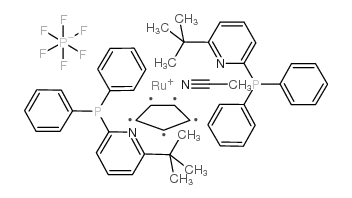776230-17-2
| Name | acetonitrile,(6-tert-butylpyridin-2-yl)-diphenylphosphane,cyclopentane,ruthenium(1+),hexafluorophosphate |
|---|---|
| Synonyms | acetonitrilebis[2-diphenylphosphino-6-t-butylpyridine]cyclopentadienylruthenium(ii) hexafluorophosphate |
| Molecular Formula | C49H52F6N3P3Ru |
|---|---|
| Molecular Weight | 990.93900 |
| Exact Mass | 991.23200 |
| PSA | 90.34000 |
| LogP | 13.20840 |
|
Section 1: Product Identification Acetonitrilebis[2-diphenylphosphino-6-t-butylpyridine]cyclopentadienylruthenium (II) hexafluorophosphate, min. Chemical Name: 98% CAS Registry Number:776230-17-2 Formula:Ru(C5H5)(CH3CN)[C21H22NP]2+PF6- EINECS Number:none
Chemical Family:metal phosphine complex Synonym:Acetonitrile-cyclopentadienyl-bis[2-diphenylphosphino-6-t-butyl pyridine]ruthenium (II) hexafluorophosphate Section 2: Composition and Information on Ingredients IngredientCAS NumberPercentACGIH (TWA)OSHA (PEL) Title compound776230-17-2100%2.5mg/m3 (as F)2.5mg/m3 (as F) Section 3: Hazards Identification Emergency Overview:Irritating to the respiratory tract, skin and eyes. May be harmful if swallowed. Primary Routes of Exposure:Inhalation, skin, eyes Eye Contact:Causes irritation of the eyes. Skin Contact:Causes slight to mild irritation of the skin. Inhalation:Dust is irritating to the nose, mucous membranes and respiratory tract. Ingestion:No specific information is available on the physiological effects of ingestion. May be harmful if swallowed. Acute Health Affects:Irritating to skin, eyes and respiratory tract. May be harmful if swallowed. Chronic Health Affects:Prolonged exposure to hydrolysable fluorine compounds can cause deterioration of bone and tooth structure. NTP:No IARC:No OSHA:No SECTION 4: First Aid Measures Immediately flush the eyes with copious amounts of water for at least 10-15 minutes. A victim may need Eye Exposure: assistance in keeping their eye lids open. Get immediate medical attention. Wash the affected area with soap and water. Remove contaminated clothes if necessary. Seek medical Skin Exposure: assistance if irritation persists. Remove the victim to fresh air. Closely monitor the victim for signs of respiratory problems, such as difficulty Inhalation: in breathing, coughing, wheezing, or pain. In such cases seek immediate medical assistance. Seek medical attention immediately. Keep the victim calm. Give the victim water (only if conscious). Induce Ingestion: vomiting only if directed by medical personnel. SECTION 5: Fire Fighting Measures Flash Point:no data Autoignition Temperature:no data Explosion Limits:no data Extinguishing Medium:carbon dioxide, dry powder or foam If involved in a fire, fire fighters should be equipped with a NIOSH approved positive pressure self-contained Special Fire Fighting Procedures: breathing apparatus and full protective clothing. Hazardous Combustion andIf involved in a fire this material may emit toxic organic fumes, carbon monoxide and carbon dioxide. Decomposion Products: Unusual Fire or Explosion Hazards: No unusual fire or explosion hazards. SECTION 6: Accidental Release Measures Spill and Leak Procedures:Small spills can be mixed with vermiculite or sodium carbonate and swept up. SECTION 7: Handling and Storage The material will degrade on prolonged exposure to air. Store and handle under an inert atmosphere of Handling and Storage: nitrogen or argon. Keep bottle tightly sealed and away from heat and direct sunlight. SECTION 8: Exposure Controls and Personal Protection Eye Protection:Always wear approved safety glasses when handling a chemical substance in the laboratory. Skin Protection:Wear protective clothing and gloves. Ventilation:If possible, handle the material in an efficient fume hood. If ventilation is not available, a respirator should be worn. The use of respirators requires a Respiratory Respirator: Protection Program to be in compliance with 29 CFR 1910.134. Ventilation:If possible, handle the material in an efficient fume hood. Additional Protection:No additional protection required. SECTION 9: Physical and Chemical Properties Color and Form:yellow microxtl. Molecular Weight:990.94 Melting Point:no data Boiling Point:no data Vapor Pressure:no data Specific Gravity:no data Odor:none Solubility in Water:insoluble SECTION 10: Stability and Reactivity Stability:air sensitive Hazardous Polymerization:No hazardous polymerization Conditions to Avoid:contact with air. This material may degrade on prolonged exposure to air. Incompatibility:strong oxidizing agents, air and halogens carbon monoxide, carbon dioxide, phosphorous pentoxide, ruthenium salts, organofluorides and organic Decomposition Products: fumes SECTION 11: Toxicological Information RTECS Data:No information available in the RTECS files. Carcinogenic Effects:no data Mutagenic Effects:no data Tetratogenic Effects:no data SECTION 12: Ecological Information Ecological Information:No information available SECTION 13: Disposal Considerations Disposal:Dispose of according to federal, state and local regulations. SECTION 14: Transportation Shipping Name (CFR):Non-hazardous Hazard Class (CFR):NA Additional Hazard Class (CFR):NA Packaging Group (CFR):NA UN ID Number (CFR):NA Shipping Name (IATA):Non-hazardous Hazard Class (IATA):NA Additional Hazard Class (IATA):NA Packaging Group (IATA):NA UN ID Number (IATA):NA SECTION 15: Regulatory Information TSCA:Not listed in the TSCA inventory SARA (Title 313):Title compound not listed Second Ingredient:none SECTION 16 - ADDITIONAL INFORMATION N/A |
| Hazard Codes | Xi |
|---|---|
| Risk Phrases | 36/37/38 |
| Safety Phrases | 26-36/37/39 |
